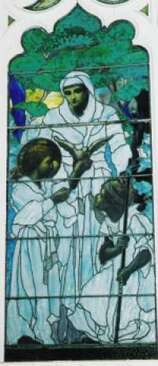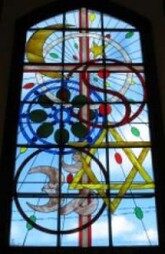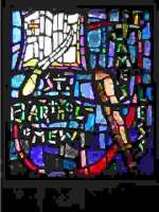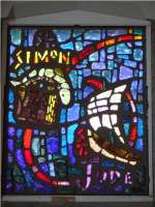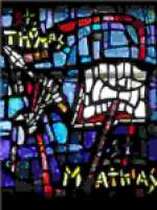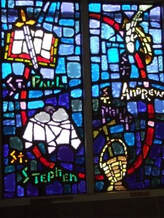OUR STAINED GLASS & ICONS
St. Elizabeth’s is blessed with beautiful stained glass and artwork.
|
St. Elizabeth with Jesus and St. John - Tiffany Stained Glass Window
In 1904, the children of Mr. and Mrs. William A. Procter gave the Tiffany glass window to St. Elizabeth’s Episcopal Church in memory of their mother, Mrs. Charlotte Elizabeth Procter. The window was originally designed for the original St. Elizabeth’s building which stood adjacent to the current church building on the same property. The stained glass window stood above the altar of the original church. This pre-eminent position was retained when the stained glass windows were removed and installed in the present church. Dated ca. 1903-1904, it is composed of multiple colored glass panels set in a Romanesque arch. St. Elizabeth is standing behind Jesus and St. John. Jesus is standing on the left, holding a dove while St. John is seated on the right, holding a staff. The large center panel is flanked by four small rosette panels and two longer panels with rosettes. |
|
The House of Prayer Window
This is placed in the entry gallery of St. Elizabeth’s and was given by Stella Ho Lau in memory of her husband, Yuen Lin Lau, and her parents, Mr. and Mrs. Ho Kee Seu. The symbols of six major religions are depicted, including Islam, Buddhism, Hinduism, Shintoism, and Judaism, woven through the Cross of Christ. The project of installing stained glass windows in the clerestory, chapel and nave of the church was initiated by Richard C. Ching, the Junior Warden in 1976-1977. The symbolic designs represent the vocations of some of the prophets and the apostles. |
|
St. Bartholemew & St. James the Less
The open book represents St. Batholemew preaching the Good News, and the knife depicts his death by being literally skinned alive with a flaying knife. Given by Chew and Ruth Lau Wong, Kim Loon and Evelyn Lau Ching, Oswald J. B. and Jasmine Notley Lau in honor of Mrs. Mary Kong Lau. St. James the Less' symbol is the fuller’s bat. He met his martyr's death by being beaten for his faith. Given by Bill Eng and family in memory of On Kee Eng. |
|
St. Simon & St. Jude
For St. Simon, the fish represents the Greek word IXOYE which stands for “Jesus Christ, God’s Son, the Savior.” The book is the Bible. The missionary boat with its sails filled out with the wind and flag flying represents Jude, a great missionary, who sailed throughout the Roman world preaching. Given by Myron H. and Loren K. Wong, Jerilyn W. Pang, and Garen K. Wong in honor of Kam Chew and Violet Lau Wong. |
|
St. Matthew & St. James
The treasure box represents St. Matthew's call to discipleship from being a hated tax collector and the Pilgrim’s staff and wallet represent St. James’ many travels throughout the Mediterranean area. Given by Akana and Salome L. Chun, Helen C. and Percy Chung, Tai Yee and Beatrice L. Chun, Alice C. and Wesley Sakaai, Thomas T. W. and Loretta A. Chun, Janet C. and Lawrence Okuna in memory of Sut and Ngun Lum Chun. |
|
St. Thomas & St. Matthias
A patron saint of builders, St. Thomas is represented by the arrow, a spear and a carpenter’s square. The Gospel Preacher, St. Matthia is represented by the headman’s axe and an open book. The axe is the symbol of his being beheaded. Given by David Yuen and Lovey Kripp Ho and Myra Yee Len Ho in memory of Tai Yin and Chin See Ho, En Fo and Yuk Lan Chong Ho. |
|
St. Paul, St. Andrew and St. Stephen
The open Bible and Sword of the Spirit represent St. Paul preaching the gospel with boldness fired up by the Spirit. The two fish forming an “X” or cross represent St. Andrew as a fisherman, the fisher of men, and his crucifixion on a cross. St. Stephen, a Deacon and Martyr, he was stoned to death for his belief that Jesus of Nazareth was Jesus the Christ. His symbol consists of stones and a garment. Given by Ellen Ching Au, Kim Tet and Florence Chang Ching, James S. and Helen K. Ching, Kim Loon and Evelyn Lau Ching, Nelson H. and Abigail R. Ching, Fook Heong and Lily Lau Ching, Kim Fo and Shi Yau Ching, Donald S. and Mary Jane Ching in memory of Sam Fat and Lyau Shee Ching, Herbert F. Ching, Elizabeth Kam Ching, Gladys Yap Ching, David C. Au and Verna Ching Lee. |
|
St. Peter & St. John
The keys and inverted cross represent two of the major events of St. Peter's life. He was also known as Simon Peter. The inverted cross is for his martyrdom. Before he died, he pleaded with his tormentors to crucify him upside down, because he was not worthy to die the same way Jesus had died. The serpent in the chalice represents the testing that St. John withstood. he was commanded to drink a poison instead of wine. He rapyed and took the cup, but before he could drink it, God turned it into a serpent which fell to the floor. Given by Richard T. F. and Charlotte C. Lum, Harold T. C. and Frances Ching, Kenneth T. K. and Patsy D. Ching, Norman T. F. and Lydia Ching, Dr. Koon Tuck and Gaelic C. Ma in honor of Richard C. and Lucy Fong Ching. |
|
St. Elizabeth and the Infant St. John the Baptist
This icon was written by Pauline (“Polly”) Gifford, wife of St. Elizabeth’s former Rector, The Rev. Dr. Gerald G. Gifford. Polly studied under Fr. Damian Higgins, a priest and monk of the Ukrainian Catholic Church. In keeping with traditional iconographic techniques, only natural substances are used in preparing it, such as soil and egg white. |
Iesu Kristo o Hawai'i (Christ of Hawai'i Nei)

This icon was written by Fr. Damian Higgins and blessed on November 30, 2008, to the glory of God in thanksgiving for the life of Joscelind Zee, given by Colette Herrick, daughter of Joscelind and by Joscelind’s loving family.
The icon is prepared on poplar wood boards braced in the back with oak. The wood is soaked in skin glues, wrapped in fine linen and coated with ten layers of Gesso (crushed marble and skin glue). The icon itself is written with all-natural based materials using the traditional egg yolk tempera method. Christ’s halo and background are surfaced with 23K gold. The halo is embossed with a breadfruit pattern (representing the Tree of Life). It is embedded with seventeen Tahitian pearls representing all the islands and atolls that comprise Hawaii Nei. Christ is dressed as priest and physician (healer). He holds a branch of ti leaves (sign of power against evil and sign of peace or truce). He wears a white kihei garment. His skin tone is Polynesian, while as is traditional in all iconography, His skin radiates light as Christ is the Light of the World. Standing in the water, it is reminiscent of the Pacific Ocean. The water represents traditional depictions of Christ in the icons of the Theophany where Christ stands in the River Jordan and is baptized by John the Baptist by which all water is blessed. The surrounding landscape evokes the volcanic ridges of Hawaii Nei with the ohia lehua. The iiwa bird, from which the feathers of the royal capes of the ali’i of Hawaii were made, is also depicted in the landscape. The sun is enshrouded in clouds with rain falling, suggesting Christ as the fulfillment of prophesy as the Light of the World and the sky Fathers (wakea). Surrounding the icon is a border in a kapa (tapa) pattern.
The icon is prepared on poplar wood boards braced in the back with oak. The wood is soaked in skin glues, wrapped in fine linen and coated with ten layers of Gesso (crushed marble and skin glue). The icon itself is written with all-natural based materials using the traditional egg yolk tempera method. Christ’s halo and background are surfaced with 23K gold. The halo is embossed with a breadfruit pattern (representing the Tree of Life). It is embedded with seventeen Tahitian pearls representing all the islands and atolls that comprise Hawaii Nei. Christ is dressed as priest and physician (healer). He holds a branch of ti leaves (sign of power against evil and sign of peace or truce). He wears a white kihei garment. His skin tone is Polynesian, while as is traditional in all iconography, His skin radiates light as Christ is the Light of the World. Standing in the water, it is reminiscent of the Pacific Ocean. The water represents traditional depictions of Christ in the icons of the Theophany where Christ stands in the River Jordan and is baptized by John the Baptist by which all water is blessed. The surrounding landscape evokes the volcanic ridges of Hawaii Nei with the ohia lehua. The iiwa bird, from which the feathers of the royal capes of the ali’i of Hawaii were made, is also depicted in the landscape. The sun is enshrouded in clouds with rain falling, suggesting Christ as the fulfillment of prophesy as the Light of the World and the sky Fathers (wakea). Surrounding the icon is a border in a kapa (tapa) pattern.
Tongan Tapas
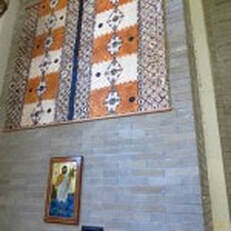
Even though Tongans are dispersed around the world, they still value traditional Tongan tapa, particularly at rites of passage times. Since the passing of Father Saimone Lino in early January, two handsome Tongan tapas have been given to the Diocese.
Tapas are a sign of traditional wealth that are accumulated but also repurposed and re-gifted for another event. For a funeral, there is insufficient time to make a new tapa, so an accumulated one can be re-given to the family of the deceased or someone who was important to the family. The Lino family presented Bishop Fitzpatrick with a large Tongan tapa in honor of his services to the family and the Tongan community. There are many Tongan members of Saint Elizabeth’s church including a vibrant Tongan Choir.
Bishop Bob and Bea Fitzpatrick are trying to figure out the best location to display this splendid work of art, which is 18 by 30 feet. When Bea Fitzpatrick asked me to photograph the tapa, it was folded in half. Even doubled over, it covered a large portion of the floor of the Von Holt Room. A classmate of mine, Maile Drake, of Tongan ancestry, specializes in researching and writing about Tongan tapa. She granted Bea and me a Saturday morning to explain the significance of the designs. There are vertical rows with squares depicting the crest of the royal Tongan family with symbols of the crown, cross, spears and flags. On each crest is the phrase: “Koeotua Motongakoha Tofia” which means “God and Tonga is my heritage.”
The vertical rows on each side on the tapa feature scenic designs with rows of pine trees, star, moon and sun. Maile explained that pine trees are of course trees introduced from Europe, but that design alludes to the rows of pine trees leading up to the royal palace. With all of these symbols of the royal Tongan family, this tapa is appropriate for any occasion and worthy to give to someone in high position, such as our Bishop.
Another aspect of this tapa that makes it so traditional is that it is constructed with wauke or paper mulberry bark. It takes a tremendous amount of time to harvest, prepare and pound into sheets. In today’s world where many Tongans are spread across the Pacific and the mainland and working full-time jobs, they do not have the necessary time to start from scratch. Contemporary Tongan tapa is often based upon what Maile refers to as “Viline”. In Hawai’i non-fusible (non-adhesive) polyester interfacing is used to simulate tapa as it is in Tonga. Fabric stores in Hawai’i carry Pellon, a brand name that Hawaiian hula halau use as a substitute tapa for costumes because it has the “poof” (body) and takes dyes well. Modern day Tongans often start with Pellon or “Viline” for the background fabric using dye to paint either traditional designs or contemporary pictures.
These tapas, both the one given to Bishop Fitzpatrick and the one given to Saint Elizabeth’s church, are truly traditional in use of paper mulberry background material and design patterns. Mrs. Fane Lino cut a 12’ by 12’ section from a larger tapa, which was stapled onto a wooden dowel to support its weight while hanging. Members of the Pacific Islander Ministry Committee assisted Charles Steffey, carpenter, in hanging the tapa high on the back wall of Saint Elizabeth’s nave. This deep-toned tapa is truly a dramatic addition to Saint Elizabeth’s Church. Both tapa, the one hanging in Saint Elizabeth’s and the one still in need of the right display location are gifts of great value from the Lino family to the Diocese. They both represent the best of traditional Tongan art in the use of material and design.
Tapas are a sign of traditional wealth that are accumulated but also repurposed and re-gifted for another event. For a funeral, there is insufficient time to make a new tapa, so an accumulated one can be re-given to the family of the deceased or someone who was important to the family. The Lino family presented Bishop Fitzpatrick with a large Tongan tapa in honor of his services to the family and the Tongan community. There are many Tongan members of Saint Elizabeth’s church including a vibrant Tongan Choir.
Bishop Bob and Bea Fitzpatrick are trying to figure out the best location to display this splendid work of art, which is 18 by 30 feet. When Bea Fitzpatrick asked me to photograph the tapa, it was folded in half. Even doubled over, it covered a large portion of the floor of the Von Holt Room. A classmate of mine, Maile Drake, of Tongan ancestry, specializes in researching and writing about Tongan tapa. She granted Bea and me a Saturday morning to explain the significance of the designs. There are vertical rows with squares depicting the crest of the royal Tongan family with symbols of the crown, cross, spears and flags. On each crest is the phrase: “Koeotua Motongakoha Tofia” which means “God and Tonga is my heritage.”
The vertical rows on each side on the tapa feature scenic designs with rows of pine trees, star, moon and sun. Maile explained that pine trees are of course trees introduced from Europe, but that design alludes to the rows of pine trees leading up to the royal palace. With all of these symbols of the royal Tongan family, this tapa is appropriate for any occasion and worthy to give to someone in high position, such as our Bishop.
Another aspect of this tapa that makes it so traditional is that it is constructed with wauke or paper mulberry bark. It takes a tremendous amount of time to harvest, prepare and pound into sheets. In today’s world where many Tongans are spread across the Pacific and the mainland and working full-time jobs, they do not have the necessary time to start from scratch. Contemporary Tongan tapa is often based upon what Maile refers to as “Viline”. In Hawai’i non-fusible (non-adhesive) polyester interfacing is used to simulate tapa as it is in Tonga. Fabric stores in Hawai’i carry Pellon, a brand name that Hawaiian hula halau use as a substitute tapa for costumes because it has the “poof” (body) and takes dyes well. Modern day Tongans often start with Pellon or “Viline” for the background fabric using dye to paint either traditional designs or contemporary pictures.
These tapas, both the one given to Bishop Fitzpatrick and the one given to Saint Elizabeth’s church, are truly traditional in use of paper mulberry background material and design patterns. Mrs. Fane Lino cut a 12’ by 12’ section from a larger tapa, which was stapled onto a wooden dowel to support its weight while hanging. Members of the Pacific Islander Ministry Committee assisted Charles Steffey, carpenter, in hanging the tapa high on the back wall of Saint Elizabeth’s nave. This deep-toned tapa is truly a dramatic addition to Saint Elizabeth’s Church. Both tapa, the one hanging in Saint Elizabeth’s and the one still in need of the right display location are gifts of great value from the Lino family to the Diocese. They both represent the best of traditional Tongan art in the use of material and design.
